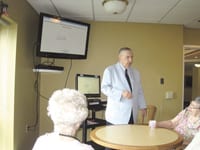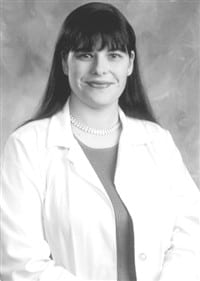Building a Pipeline of Innovation Institute for Applied Life Sciences Bridges Academia, Industry
Peter Reinhart acknowledged that the acronym IALS (pronounced ‘aisles’), short for the Institute for Applied Life Sciences at UMass Amherst, hasn’t yet become part of the national or even the regional lexicon.
And it’s an unofficial component of his job description to change that.
Reinhart, a veteran biopharmaceutical executive and researcher, was recently named founding director of the institute, which was created in 2013 with $150 million in capital funding from the Massachusetts Life Sciences Center (MLSC) and additional contributions from the university. Its mission is to accelerate life-science research and advance collaboration with industry to effectively shorten the gap between scientific innovation and technological advancement.
And Reinhart, a native of Australia whose résumé includes a number of intriguing stops, most of them in the sector now known as ‘large pharma,’ is excited about this latest career opportunity and bullish about its prospects for carrying out that assignment.
“This is really intriguing to me; professionally, this is really what I want to do — take innovative ideas and turn them into meaningful products, things that people can use,” he said, adding that the ultimate goal is to create a pipeline of leading-edge products at various stages of development.
The IALS will do this through the creation of three translational centers:
• The Center for Models to Medicine, which identifies and validates new therapeutic pathways and clinical development candidates, focused on areas of expertise such as protein homeostatis;
• The Center for Bioactive Delivery, which seeks to discover a new paradigm for the discovery of optimized delivery vehicles for drugs and nutriceutical compounds; and
• The Center for Personalized Health Monitoring, which is developing nanotechnology and large-dataset management to improve healthcare through low-cost, wearable, wireless sensors that analyze patient data continuously in real time.
Reinhart comes to the university from Alzehon, a Lexington, Mass. company where he most recently was the head of corporate development and new products for the firm, which is focused on brain health, memory, and aging and development of treatments for Alzheimer’s disease and other neurodegenerative disorders. Prior to that, he was chief scientific officer and then president at Proteostasis Therapeutics, and head of neurodegeneration at Wyeth/Pfizer. He has also been an adjunct associate professor of Neuroscience at the Duke University Medical Center for the past decade and was a tenured professor at the center for nearly 13 years prior to that.
He told HCN that he became interested in leading the IALS because he considered it a logical next step in a career that has blended academia, cutting-edge industrial-biomedical research, development of startup companies, and work with major pharmaceutical corporations.
“Having spent significant time in large pharma, biotechnology companies, as well as academia allows me to understand the strengths and needs of each of these organizations,” he said. “This experience will be useful both in advancing alliances across the UMass campuses to combine assets and capabilities and in utilizing such assets to develop industry partnerships.”
For this issue, HCN talked at length with Reinhart about the IALS, its ambitious goals, and how he intends to meet them.
Down to a Science
As he discussed the circumstances that brought him to the Amherst campus and, more specifically, its new Life Sciences Laboratories, Reinhart referenced one of a series of talks (this one was in Boston) he gave while he was at Pfizer.
“These talks were about how to combine the best aspects of academic innovation with the ability of industry to take an idea and turn it into a product on a timeline and on a budget,” he told HCN. “While I was at Boston, someone from UMass contacted me and said, ‘I heard you give this talk … and we’re about to start something fairly similar in this space; it’s called the Institute for Applied Life Sciences, and the vision really is to have a more product-focused, outward-looking directionality to some of the basic research we’re doing, with the idea that this would become a number of translational programs that could partner with industry, which would lead to creation of a local infrastructure surrounding UMass.’
“And I thought ‘this is amazing — this is exactly what I pitched to the CEO at Pfizer,’” he recalled. “The difference is, I pitched it with the idea that we could run this within large pharma and reach out to academia. And what UMass was doing is exactly the same concept, but they were running it from within academia and reaching out to industry. And I could easily see that you could run this concept from either side.”
Fast-forward through several rounds of interviews and visits to the campus with his wife, who soon became sold on the university and Amherst in general, and Reinhart is now one of the point people in the Commonwealth’s ambitious, $1 billion initiative to become even more of a national and global leader in the life sciences.
He started on Oct. 1 and is still in the process of fitting out his office (his printer arrived he day he talked with HCN), hiring staff, and meeting with representatives of many constituencies who will be involved with the center.
As he talked about its prospects moving forward, Reinhart said he thought all the ingredients were in place to translate that concept he discussed while giving those talks for Pfizer into reality.
Listing these ingredients, he mentioned everything from the faculty at UMass, which he said had the willingness (generally not common in academia) to embrace something new and fundamentally different, to the infrastructure at UMass, meaning both the physical facilities and the leadership team, to a firm vision for what those involved want to accomplish.
And when he looked at how those ingredients might come together, he decided that this was an opportunity he couldn’t pass up.
Elaborating, he said the IALS represents a unique concept within the broad life-sciences universe, something that he’s excited about bringing to fruition.
“On paper, there are other institutes that call themselves translational,” he explained. “But translational is a word that has many different meanings depending on who’s using it. And in the way I see translational — where you’re combining the best of academic innovation and industry know-how, I don’t think there’s another facility like this.”
Not Lost in Translation
Reinhart said some of his initial projects at the IALS include creation of a strategic plan for the facility — there exists a broad concept, but he wants something more detailed and comprehensive — as well as development of both an operational structure and an operational philosophy.
Overall, he wants to take the team approach that is so common, and successful, in industry and incorporate it on the academic and research sides, where it is far less prevalent.
“Industrial science, by definition, is a team sport, because once industry engages on a project, there are more than 50 people working on it, and the way you get real progress in a short period of time is to have people with different expertises coming together and working together,” he explained. “This is something that I want to achieve in the institute; it wouldn’t be individual programs run by single PIs (principal investigators) that advance a concept, but rather groups of people coming together that have related, but not overlapping, areas of expertise working together on a project to advance it toward commercialization and toward commercial partnerships.
“What I’m really trying to do is have multiple different laboratories and, frankly, even other sites, such as UMass Medical Center, participate in specific projects,” he went on.
Elaborating, he said he envisions the institute working in a way similar to a large technology company or large pharmaceutical corporation, with a number of initiatives ongoing at the same time, with the goal of creating that aforementioned pipeline of innovative products.
“Some of these are closer to commercialization, and others are further away,” he said. “We have some that are much closer to commercialization today — exactly how close is still to be determined — and, of course, we have others that are more embryonic and earlier-stage. But the concept is to develop a pipeline, the leading edge of which should start creating products and partnerships with academic entities in a three- to five-year time frame.”
Referencing the Center for Personalized Health Monitoring specifically, Reinhart said there are several products in or approaching the prototype phase, and some may be ready for potential development in a few years, giving the institute an opportunity to play a lead role in a rapidly emerging sector within the life-sciences industry.
“The world is realizing that wearable devices and electronic monitoring is a real growth area,” he explained. “Right now, it’s either at the stage of small entrepreneurial companies or, occasionally, large enterprises such as Google, which is becoming more and more interested in areas like that; they’re pushing the envelope in this area.
“There are not very many, if any, academic centers that are trying to combine the innovation coming out of individual research labs with an ability to translate that into a device or monitoring equipment or a compound that can be advanced into the clinic,” he went on. “Bringing these concepts together within an academic setting is something quite novel.”
And if this novel facility can become successful at providing a steady flow of products through that pipeline, then Rinehart shouldn’t have any trouble making IALS an acronym known across the region, and perhaps around the world.



